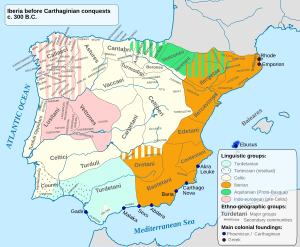Turduli facts for kids
The Turduli (also called Turtuli) were an ancient group of people who lived in the southwestern part of the Iberian Peninsula a very long time ago, before the Romans arrived. They were known in Greek as Tourduloi.
Where the Turduli Lived
The Turduli tribes mainly lived in what is now southern and central Portugal. This included areas like eastern Beira Litoral, the coast of Estremadura, and Alentejo along the Guadiana river valley. They also lived in parts of Extremadura and Andalusia in Spain.
Their main city was an old fortified town called Ibolca. The Romans later called it Obulco. Today, this city is known as Porcuna, located between the Spanish provinces of Córdoba and Jaén. Other important towns linked to the Turduli included Budua (Badajoz), Dipo (Guadajira), Mirobriga (Capilla), and Sisapo (Almadén).
Who Were the Turduli?
It's not completely clear where the Turduli originally came from. Some old writings say they were related to the Turdetani people, who lived in a region called Baetica (modern Andalusia).
We know a little about the original Turdulian language from a few old tomb writings. Studies of these texts suggest the early Turduli spoke an Indo-European language. Some experts think it might have been similar to languages like Paeonian or Mysian, which were spoken far away in the Balkans. They might also have had cultural links to the Ligurians and Illyrians.
However, later on, the Turduli were often seen as Celts. This suggests they were greatly influenced by nearby tribes, such as the Celtici.
The History of the Turduli
A Greek explorer named Pytheas, who lived in the 4th century BC, wrote about the Turduli. His writings were later mentioned by Strabo in the 1st century AD. Pytheas said the Turduli's original home was north of Turdetania. This was the region where the ancient kingdom of Tartessos was located, near the Guadalquivir River. The Turduli's old capital, Regina Tourdulorum, was in this area. Today, this place is Reina in the Badajoz region of Spain.
Around 530 BC, the kingdom of Tartessos fell apart. Also, new groups of Celtici people started moving into the area between the 6th and 5th centuries BC. These events caused many Turduli people to move from their homes.
Most of them settled in the middle part of the Anas river basin, which is now the Guadiana River. This area became known as Beturia or Baeturia Turdulorum. It covered parts of eastern Alentejo, western Badajoz, and southeastern Huelva provinces. These people were then called the Baetici Turduli.
Other Turduli moved west. They settled in the central coastal region of Portugal, known as Estremadura. These groups became known as the Turduli Oppidani. Some went south, settling near the Setubal peninsula, close to the mouth of the Tagus river and the lower Sado river valley. They were called the Bardili.
The remaining Turduli, called Turduli Veteres in old texts, moved north. They traveled with the Celtici people and eventually settled in Beira Litoral. This is a coastal area along the lower Douro and Vouga river basins.
See also
 In Spanish: Túrdulos para niños
In Spanish: Túrdulos para niños
- Bardili (Turduli)
- Cynetes
- Tartessos
- Turdetani
- Turduli Oppidani
- Turduli Veteres
- Pre-Roman peoples of the Iberian Peninsula


